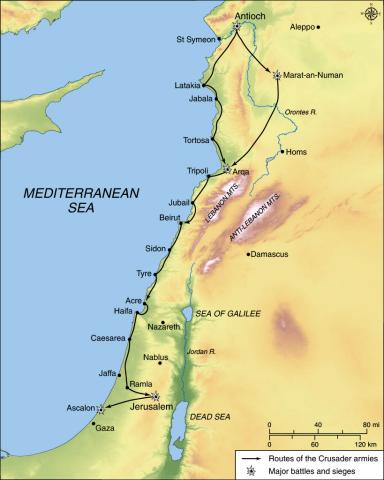The March to Jerusalem
[10.34.2] Vidēns autem Raimundus quod nūllus seniōrum voluisset, causā ēius, īre in viam Sānctī Sepulchrī, exīvit nūdīs pedibus dē Marrā, decimā tertiā diē intrante Iānuāriō, et pervēnit usque Capharda, fuitque ibi per trēs diēs. Illīc adiūnxit sē comes Nortmanniae comitī Raimundō. Rēx autem Caesarēae multotiēns mandāverat per suōs nūntiōs comitī Marrae et Caphardae quod cum eō pācem vellet habēre, et dē suō pretium eī daret; et Chrīstiānōs peregrīnōs dīligeret, fīdūciamque faceret quia, quantum continet ēius imperium, peregrīnīs nōn esset offendiculum; et mercātum dē equīs et dē corporālibus alimentīs daret gaudenter.
notes
(January 1099) Raymond of Touolouse sees that his feud with Bohemond has put a stop to the crusade, so walks barefoot to a nearby town as a signt of repentance. The Muslim ruler of Caesarea (Shaizar) offers to cooperate with the advancing crusaders.
exīvit nūdīs pedibus: Raymond was making a conspicuous display of either penitence (for his feud with Bohemond?) or his Christian piety.
decimā tertiā diē intrante Iānuāriō: January 13, though see 10.33.4
Capharda: modern Kafartab, in NE Syria.
Rēx autem Caesarēae: The emir of what is now Shaizar, in NE Syria; his name was Ali ibn Munquidh.
mandāverat: note the appropriate use of the pluperfect.
et dē suō pretium eī daret: “and would give him a reward from his (property).”
quantum continet ēius imperium: "for as long as his empire holds (them)," i.e., as long as the crusaders were in his territory.
vocabulary
multotiens: many times, often
offendiculum –ī, n.: stumbling block, obstacle

